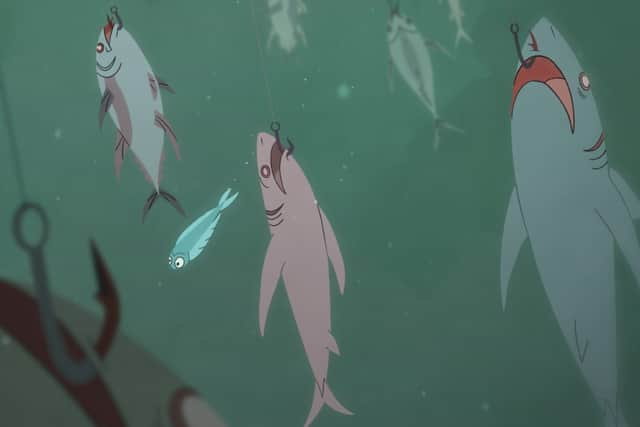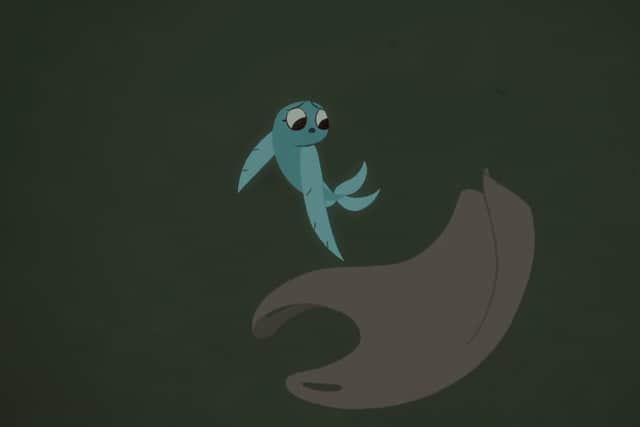Ocean sanctuaries: Greenpeace campaign video urges UK to sign new treaty and get to work protecting the seas
The UK is being urged to use new powers to help create safe havens for marine life in increasingly under-pressure seas - to help meet an ambitious ocean protection target.
Climate campaign group Greenpeace has today (14 September) released a new video campaign, a week before world governments are set to formally sign a historic global ocean treaty at the United Nations headquarters.
Advertisement
Hide AdAdvertisement
Hide AdThe treaty will give them the power to establish new marine sanctuaries, with the climate campaign group urging the UK government to use this power to help protect the North Atlantic's Sargasso Sea - a site of huge ecological significance.
The campaign video features the voices of Jane Fonda and Camila Cabello as a flying fish and an eel. The pair dodge trawling nets, bleached coral reefs, plastic waste and pollution gushing into the sea from pipes as they search for clean water, before a kindly whale - voiced by Simon Pegg - directs them to a marine sanctuary.


"This is a story about survival. Against all the odds, a chance for life to thrive," Pegg can be heard saying as the video opens. As the fish embrace life in their new sanctuary home, Pegg’s voiceover continues: “Our oceans are under threat and time is running out.
"World leaders finally agreed a Global Ocean Treaty that can protect the oceans, our home. Now they must use this Treaty to create ocean sanctuaries where marine life can recover and thrive.”
Advertisement
Hide AdAdvertisement
Hide AdCurrently, less than 1% of the high seas are protected, Greenpeace says, but the United Nations' agreed-upon biodiversity target is to protect 30% of the world's oceans by 2030. To reach it, around 11 million square kilometres of ocean must be protected every year - more than the surface of the UK and Canada combined.
Fiona Nicholls, of Greenpeace’s Protect the Oceans campaign, said: "destructive industrial practices at sea threaten the future of ocean health and by extension, the future health of our whole planet.
"To give marine life a chance, at least 30% of the oceans must be protected in a network of ocean sanctuaries by 2030 - we have just seven years left," she continued. "Countries serious about ocean protection must sign the Ocean Treaty next week at the UN General Assembly and ensure that it is ratified as soon as possible.”


Mounting pressures
Greenpeace has also released a new analysis of the most serious threats facing the world's oceans, which sets out a political roadmap showing how governments can succeed at protecting 30% of the world's oceans by 2030 - by signing the new ocean treaty and starting work on proposals for new sanctuaries as soon as possible.
Advertisement
Hide AdAdvertisement
Hide AdMs Nicholls said the new ocean treaty was a historic win for nature. "But as our report shows, the threats to marine life worsen every day.
"The Treaty gives us a powerful tool to protect the oceans, but now Foreign Secretary James Cleverly must set an example to other governments by urgently signing and ratifying it," she said. "For all of our sakes, leaders must use the treaty to urgently create new ocean sanctuaries on the high seas that give our oceans and all the life within them a fighting chance."
Industrial fishing was one of the biggest threats identified in the report. Between 2018 and 2022, fishing activity in the high seas rose an estimated 8.5% - to nearly 8.5 million hours total spent fishing.
Drifting longlines - or lines with thousands of hooks which can be dozens of kilometres long - made up more than three-quarters of all recorded fishing activity, which Greenpeace said was a destructive method that resulted in high levels of bycatch.
Advertisement
Hide AdAdvertisement
Hide AdThe rise in fishing activity was even higher (22.5%) in areas of the ocean that scientists have identified as being most in need of protection, the report found. As well as fishing, it said ocean warming, acidification, pollution - including plastic pollution - and the emerging threat of deep sea mining were placing more strain on ocean ecosystems.
University of Exeter marine conservation professor Callum Roberts, who wrote the report's forward, said that 60 countries needed to ratify the treaty before it became legally binding, and the process could take years. He recommended an international target of ratifying it by 2025, so the real work can begin.
"The Global Ocean Treaty fills a gaping hole in planetary governance and protection," he wrote. "It is designed specifically to conserve marine life beyond the 200 nautical mile limits of national jurisdiction. This region is commonly known as the High Seas, and makes up an immense 61% of the world’s ocean.
"Fishing pressure across the world's oceans is immense, including in the areas earmarked for protection... But these direct pressures combine with a background of worsening chronic stress from human-caused global change. This will devastate marine life without concerted international action," he continued.
Advertisement
Hide AdAdvertisement
Hide AdThe report recommended three specific high sea sites be among the first new ocean sanctuaries: the Emperor Seamounts in the Northwest Pacific, the Sargasso Sea in the North Atlantic and the Lord Howe Rise between Australia and New Zealand.
The UK is a part of an international coalition to protect the Sargasso Sea, and Greenpeace says this makes it well placed to champion making it an ocean sanctuary.
Comment Guidelines
National World encourages reader discussion on our stories. User feedback, insights and back-and-forth exchanges add a rich layer of context to reporting. Please review our Community Guidelines before commenting.
